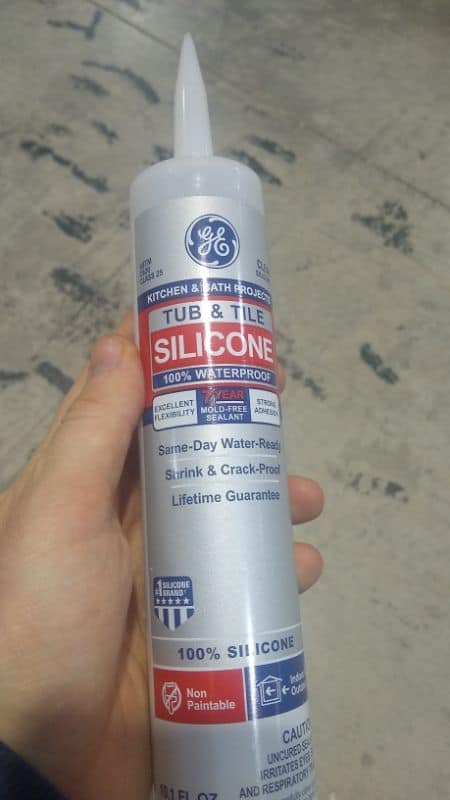Silicone is the caulk everyone loves to hate. Visit any RV forum, and you’ll see silicone lynched and hung in effigy.
Is silicone really so awful for sealing your RV? Does it ever come off? Does anything stick to silicone? How long does silicone caulk last?
(Yes, these are the questions that keep me up at night. Also, why do people drive on parkways but park on driveways …?)
Should I Use Silicone to Seal an RV?
Here’s an excerpt from my post Sealing the Outside of Your RV:
I do want to take a moment and point a finger at silicone. You’ll often hear something like “Never use silicone on an RV!”
Is this true?
For you, yes. Silicone caulks available at retail stores typically don’t adhere well to dirty or oily substrates. Worst of all, scraping off silicone doesn’t remove all the residue – and new silicone won’t stick to old silicone! As more than one RV owner has discovered, it can take many hours to properly prepare an RV for a new silicone cap sealant.
Now, to be fair, this isn’t true for all silicone products. Some silicone-based or siliconized products have exceptional adhesion – but unless you shop at a specialty roofing store, you won’t get your hands on any of these. Silicone is best used as a glazing material rather than a waterproofing sealant.
That’s the short answer: Generally, I think there are better sealants for RVs besides silicones. You can head over to my list of favorite caulks and sealants.
But silicones aren’t all as evil as you’ve been lead to believe.
Why Do RV Manufacturers Use Silicone?
We use them for a dozen reasons.
- We get better silicone than you. You’re stuck with the retail-grade silicones at Lowes, Home Depot, and your local hardware store. You get the leftovers: caulks made from the lowest grade of silicone polymer; caulks that smell like vinegar as they cure.
- Silicones are generally safe. Manufacturers go through gallons and drums of this stuff. Silicone is known to be chemically stable and generally pretty safe stuff. Meanwhile, alternatives often contain harmful solvents. You can’t use that stuff with lots of PPE and ventilation.
- Silicones are easy to apply. They’re easily “gunnable.” And they apply well in hot or cold, dry or humid weather. And they tool like a dream.
- Silicones are cheap. (Hey, it’s the RV industry.) Their relative affordability is one reason the RV industry hasn’t switched to urethane skinning sealants.
- Silicones are durable. A good sealant is darn near chemically inert. And it doesn’t break down in UV. A good silicone, properly applied, really can last for years (even decades!)
- Silicones play well with glass. Lots of sealants don’t stick to glass. Or they etch it. Silicones are a perfect match!
- Silicone is great for gaskets.
Not every manufacturer uses silicone. It also depends on the type of siding and roofing. NuFlex 311 is a silicone self-leveling sealant recommended for many Winnebago fiberglass roofs, for instance.
Fun fact: There are only a handful of silicone polymer manufacturers in the world. Big names include DOW and Elkem. Everybody else purchases their raw silicone from these manufacturers and then brews their own final concoctions.
Does Anything Stick to Silicone?!
The biggest gripe about silicone is the removal. Most retail silicones cannot be chemically or easily manually removed. Even if you peel away the bead, an oily residue will remain bonded to the surface. Even scraping won’t always remove it. Acetone won’t touch it. Alcohol does nothing. Even nasty solvents like toluene, xylene, and MEK will only soften silicone, not dissolve it.
And here’s the kicker: Most simple silicone sealers won’t stick to themselves once cured.
This is usually when the well-meaning RV owner sits down at a computer and types out: “WARNING TO ALL OTHERS: NEVER USE SILICONE ON AN RV!!!!”

So, a few notes on that.
- Firstly, understand that removing a silicone caulk means you’ll need some machine assistance. You’ll need sandpaper or an abrasive scouring pad. Most surfaces, once abrasively cleaned, will readily accept a new coat of silicone.
- Secondly, understand that silicone has tenacious cohesion. If you want it to stick to a surface, the forces of adhesion must be greater than cohesion. That means it won’t stick to a dirty, oily, wet, or grimy surface.
- Thirdly, many silicones skin over in a matter of minutes (even seconds). Once it skins, it won’t stick to anything. So you can’t wait too long to tool.
- Fourthly, silicone doesn’t play well with other chemistries. This is where many RV owners throw up their hands. They try applying another sealant over the top of the old residue, and the darn stuff won’t stick! It’s maddening.
So yes, silicone can stick to old silicone … but most cheap silicones won’t.
There are “siliconized” blends, labeled as paintable, which can be re-sealed without removal. However, these are usually siliconized latex or acrylic products. Use them for your shower, not your windows. They tend to mold and peel pretty easily.
Which is why I think you’re better off picking a different battle.
Can you use silicone on an RV? Sure, you can. And if that’s what your manufacturer specs out, I would trust their advice. There are quite a few silicone products I would use (and do use) in a heartbeat.
Just stay away from Big Box store silicones – unless you enjoy doing battle while wielding your newfound knowledge of chemical compatibilities. Isn’t RV ownership challenging enough as is?
Leave a Reply